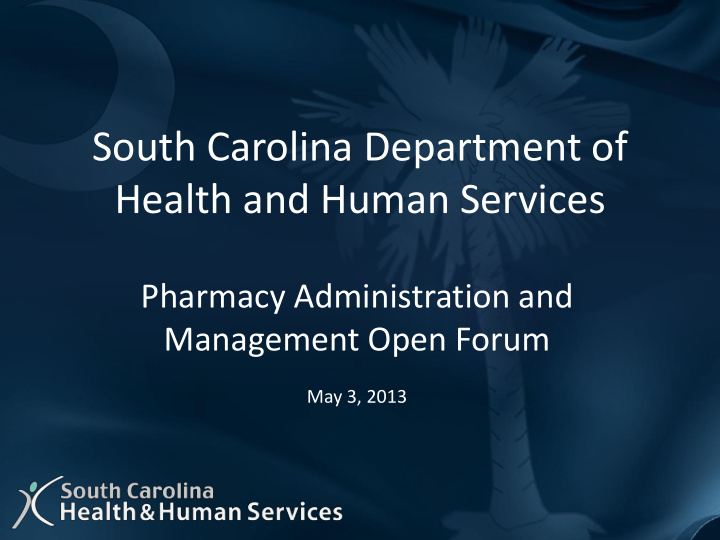



South Carolina Department of Health and Human Services Pharmacy Administration and Management Open Forum May 3, 2013
Agenda • Welcome and Forum Logistics • Introductions • Director’s Comments • Overview of Pharmacy Program • Stakeholder Input • Closing Remarks 2
Welcome and Forum Logistics • Sign-In • Comment / Recommendation Requests • Comment Cards 3
Introductions • Michael Collisi - Co-Facilitator • Michael Chowning – Co-Facilitator • Valeria Williams – Program Director • Kevin Rogers – Project Manager • Tony Keck – Agency Director SCDHHS 4
Director’s Comments 5
Past History of Pharmacy Program • Prior to 2000 SCDHHS utilized a Fee for Service (FFS) payment model • SCDHHS paid claims with limited edits • Utilization management, quality improvement were not managed during this time 6
Recent History of Pharmacy Program • RFP for Pharmacy ASO was posted in 2000, three RFPs awarded since 2000 • Goal was to provide administrative simplification, cost-effective utilization management and to reduce fraud and abuse • Contract was awarded to a single Pharmacy vendor with implementation completed in November 2000 7
Recent History of Pharmacy Program • Program enhancements over past ten years: – Prospective Drug Utilization Review – Utilization Management – MAC Program – Preferred Drug List (PDL)/Supplemental Rebate – Coordination of Benefits – Diabetic Supplies Management – Web based prior authorization (PA) – Pharmacy Lock-in Program – MCO Rebate Program 8
Previous Program Model • Member acquired prescription from the doctor • Member presented prescription to the pharmacy to be filled • Pharmacy billed Medicaid • Medicaid generated Remittance Advice • Provider enrolled with Medicaid • Member enrolled with Medicaid 9
Current Pharmacy Program • Pharmacy Administrative Services Organization (ASO) Provides Point of Sale claims editing and adjudication Supports OBRA Rebate program for both FFS and MCO Claims Provides support for the Retro Drug Utilization Review (DUR) program • ASO transfers claims to Medicaid for payment processing • Medicaid pays provider and generates Remittance Advice 10
Compliance/ Oversight Activity • Monthly Performance reporting Prior Authorization Analysis Call Center Statistics Analysis DME Product Distribution Drug Utilization Review (DUR) Activity 11
Why Change Now? • SC moving from a payer of claims to a purchaser of services with goal to: Improve health outcomes Improve beneficiary experience Reduce per-capita costs 12
Pharmacy Models • Basic Pharmacy Models – Traditional Fee for Service (FFS) – Administrative Service Organization (ASO) – Managed Care Organizations (MCO) – Hybrid Models (combination of above) 13
Pharmacy Models – FFS Member needs prescription filled Pharmacy fills prescription Pharmacy adjudicates claim at POS Medicaid processes claims Medicaid pays pharmacy Pharmacy is enrolled with Medicaid Member enrolled with Medicaid 14
Pharmacy Models – ASO Member needs prescription filled Pharmacy fills prescription Pharmacy processes claims via POS Medicaid contracts with ASO to process claims ASO pays pharmacy Medicaid pays ASO Pharmacy is enrolled with Medicaid or MCO Member enrolled with Medicaid 15
Pharmacy Models – MCO (HMO Model) Member needs prescription filled Prescription is written by MCO network provider Network pharmacy fills prescription Network pharmacy bills MCO MCO adjudicates claims MCO pays pharmacy Payment may be capitated or FFS Medicaid pays MCO PMPM Pharmacy is enrolled with MCO Member enrolled with MCO 16
Pharmacy Models – Hybrid Models Used when a single model is insufficient to meet state specific needs Combination of FFS, ASO and MCO models Typically a combination of FFS and ASO models 17
Pharmacy Models – Hybrid Models Used when states transition from FFS to another model Used when states choose to retain responsibility for successful strategies but transfer management of other responsibilities to a contractor to improve quality Used when states choose to share risk Providers enrolled with Medicaid or MCO Members enrolled with Medicaid or MCO 18
Models Used in Other States States are varied and no one solution works for all Best practices may include combinations of options or pieces of options (Hybrid) 19
Models Used in Other States – MCO models are configured in several ways • MCO handles pharmacy benefit for members in the plan • MCO members are managed out side of the plan in a FFS state managed program 20
Models Used in Other States Fee for Service Model State contract with PBA for members not in a MCO plan model includes: Call centers Prior authorizations Utilization review Claims Processing State manages a FFS model that includes claims and pharmacy operations 21
Stakeholder Input • Design a Pharmacy program model that: Improves health outcomes for members Improves the beneficiaries experience Reduces the per-capita cost of treatment Reduces administrative overhead/hassles • What is the best way to set up the Pharmacy program to meet this goal? 22
Closing Remarks Thank you for attending: SCDHHS values your input! 23
Recommend
More recommend